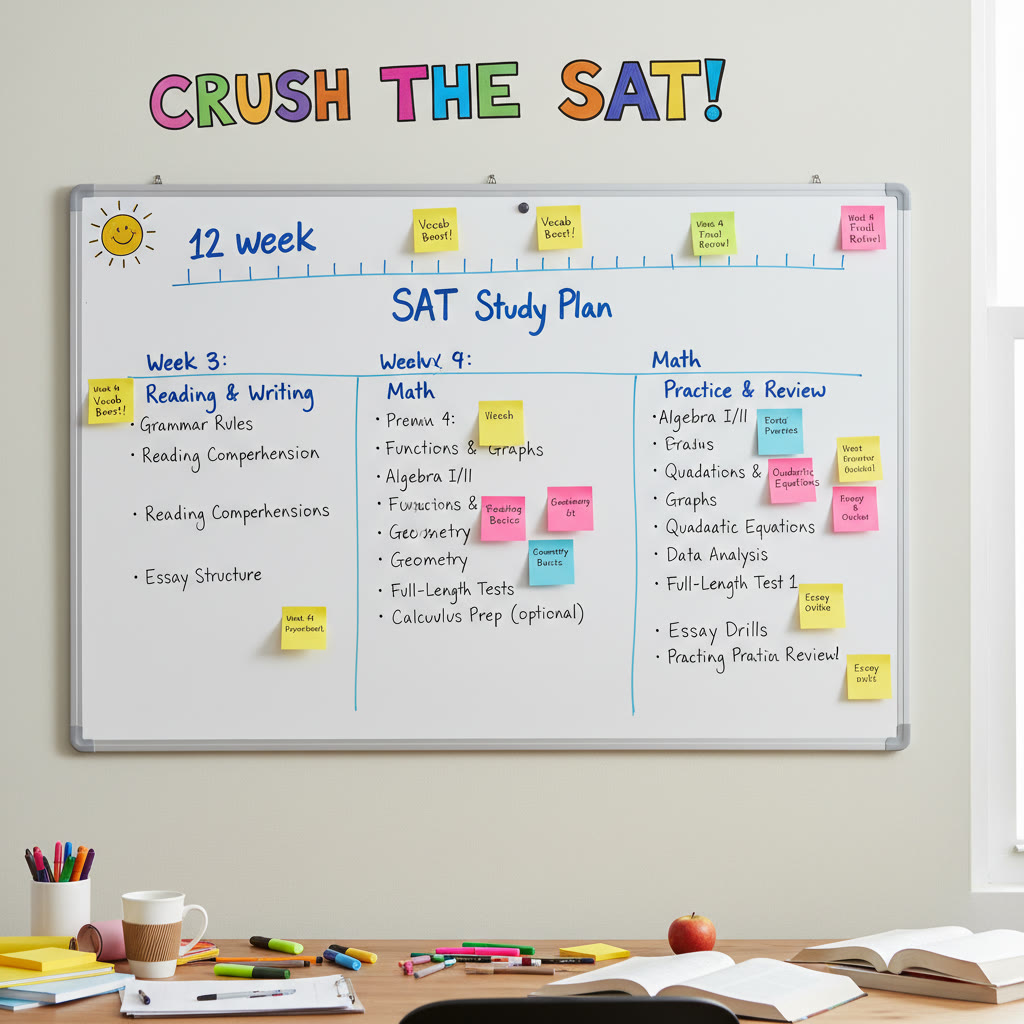How to Reframe SAT Challenges as Opportunities
Imagine walking into test day and feeling not panic, but curiosity. Not dread, but determination. That shift isn’t magic — it’s mindset, strategy, and practice. The SAT is a test of skills you can build, not a measure of some fixed trait. When you reframe the challenges the SAT throws at you as chances to learn, grow, and outsmart the exam, everything changes: study becomes purposeful, mistakes become data, and pressure becomes practice.
This post is for the student who feels stuck in a loop of timed sections, slippery grammar rules, and seemingly cryptic reading passages. We’ll walk through why reframing works, practical reframes for each SAT section, a realistic study plan, sample problems, and daily habits that make big improvements feel inevitable. Along the way you’ll see how personalized support — such as Sparkl’s personalized tutoring with 1-on-1 guidance, tailored study plans, expert tutors, and AI-driven insights — can be used when you want focused help turning specific weak spots into strengths.
Why Reframing Works
Reframing is more than motivational pep talk. It’s a cognitive tool: when you change how you label a challenge, you change the mental resources you bring to it. Neuroscience and behavioral research show that interpreting stress as a challenge (not a threat) improves focus and performance. In practical terms, reframing helps you stop wasting energy on self-doubt and use that energy to analyze, adapt, and act.
From ‘I can’t’ to ‘I can learn’
Students often say, “I’m just bad at reading dense passages” or “I’m not a math person.” Those are fixed-mindset statements. Flip them to process-oriented ones: “I can learn strategies to unpack passages” or “I can practice the types of problems that stump me until they become routine.” That single linguistic shift encourages experimentation — the heart of improvement.
Use mistakes as data
Every wrong answer gives you information. Instead of hiding it under shame, log it. Patterns emerge — maybe you misread conditionals in algebra or skip transition words in reading. Once you have a pattern, you have a plan.
Common SAT Challenges and Natural Reframes
Test anxiety → Focused activation
Reframe: Nervousness is your brain preparing to perform. Rename anxiety as “activation” and channel it.
- Short breathing routine before each section: inhale 4, hold 2, exhale 6 — two cycles resets your body.
- Turn adrenaline into a checklist: “Quick scan, question approach, timing checkpoint.” Structure calms the body.
- Practice under low-stakes simulated pressure: a timed 15-minute drill every other day reduces anxiety on test day.
Time pressure → Strategic triage
Reframe: Time limits invite strategy, not panic. Treat the clock as information. If one question is eating time, skip and revisit.
- Use the two-pass approach: answer easy/medium questions on the first pass; mark hard ones for the second pass.
- On Math sections, estimate quickly to eliminate wrong answers before doing full calculations.
Tricky wording → Puzzle clues
Reframe: Confusing questions are puzzles built with clues. Learn to spot them — contrast words, qualifiers (only, always, sometimes), and signal phrases that guide the correct choice.
Regression after practice → Evidence of growth
Reframe: Score fluctuations are expected. They highlight variability and help you focus on consistency-building drills rather than chasing a single perfect score.
Section-by-Section Reframes and Tactics
Reading: From ‘too dense’ to ‘pattern recognition’
Reframing tip: View passages as argument machines. Each paragraph has a role — claim, evidence, counterpoint. When you see the machine, you can predict the author’s moves.
- Annotate with two marks: “M” for main idea, “P” for purpose (why did the author write this paragraph?).
- Questions often ask about relationships. Translate “inference” to “what must be true if the author’s argument stands?” so you look for logical necessity, not assumed details.
Example passage strategy: If a question asks, “The author would most likely agree with…” scan for the author’s thesis and supporting tone words (e.g., ‘cautiously optimistic’) and eliminate answers that contradict that tone.
Writing & Language: From nitpicky grammar to powerful editing
Reframing tip: Think like an editor improving clarity and flow. The SAT favors concise, clear, and logical order.
- Create a mental checklist: subject-verb agreement, verb tense consistency, pronoun clarity, conciseness, transitions.
- When faced with punctuation or sentence order choices, ask: “Does this change the meaning or improve clarity?” If not, choose the simpler option.
Math (No Calculator & Calculator): From speed trap to strategy game
Reframing tip: Math problems are puzzles with predictable structures. Recognizing problem types helps you decide whether to compute, estimate, or plug in answers.
- Look for structure: quadratic? linear? proportional reasoning? Each has a favorite solving method.
- Use answer choices: plug in an answer when algebra would be messy. For example, if the answers are integers, try the middle one first.
- When time is limited, estimate or use units to eliminate implausible answers.
Example Math Problem and Reframe
Problem: A rectangle’s length is 3 times its width. If the perimeter is 48, what is the area?
Initial panic: algebra looks messy. Reframe: turn this into a simple system and solve with intuition.
- Let width = w, length = 3w. Perimeter = 2(length + width) = 2(3w + w) = 8w = 48, so w = 6.
- Area = length × width = 3w × w = 3w^2 = 3 × 36 = 108.
Reframe takeaway: Break down variables into relationships. If you can express everything in terms of one variable, the problem becomes routine.
Build a 12-Week Study Plan (Table)
Reframing works best with a plan. Below is a compact 12-week plan that turns weaknesses into strengths by alternating targeted practice, full-length tests, and consolidation weeks. You can adapt this to a shorter or longer schedule depending on how far test day is.
| Weeks | Focus | Practice Goals | Measure |
|---|---|---|---|
| 1–2 | Diagnostic & fundamentals | Take a full practice test; master basic grammar rules, algebra, and reading annotation. | Baseline score; error log categories started |
| 3–4 | Target weakest section | Focused drills (45–60 min/day); 1 timed section weekly. | Section score trend + error pattern reduction |
| 5–6 | Strategy refinement | Practice triage, estimation, and pacing drills; simulate test conditions. | Consistency in timed sections |
| 7–8 | Advanced problem types | Tackle hardest question types; mixed practice; tutor check-ins if needed. | Improved accuracy on hard items |
| 9–10 | Full-length practice | Two full tests per week, focused review of missed items. | Target score range accuracy |
| 11–12 | Consolidation & taper | Light review, confidence-building drills, sleep and nutrition routines. | Stable performance and test-day readiness |
How to use the plan
Work in focused blocks: 25–50 minutes of shallow focus, a 5–10 minute break, then a second block. Keep an error log with categories (e.g., “reading: inference vs. detail” or “math: algebraic manipulation”). Review the log weekly and turn recurring errors into drills.
Practice Routines and Micro-Habits That Compound
Small habits matter more than one-off all-nighters. Here are routines that, repeated, produce outsized gains.
Daily (30–60 minutes)
- Warm-up: 10 minutes of vocabulary in context or mental math drills.
- Focused practice: 20–40 minutes on targeted weak areas (one reading passage, two grammar sets, or a math topic).
- End with a reflection: What tripped you up? One action to fix it tomorrow.
Weekly
- One full-length, timed practice test or two section-level timed tests.
- One tutor or mentor review session — discuss patterns, not just answers. Sparkl’s personalized tutoring with expert tutors and AI-driven insights can accelerate this step when you want tailored feedback.
- One day of light, restorative study: review notes, rest, and mentally rehearse test-day logistics.
Measuring Progress: What to Track
Tracking is how you reframe setbacks into experiments. Here are practical metrics:
- Raw section scores and composite score — track over time.
- Error categories (grammar type, math concept, reading inference vs. detail).
- Timing checkpoints (how many questions left at the halfway mark of a section).
- Confidence rating for each practice section (1–5) to monitor anxiety vs. preparedness.
| Metric | Why it matters | Example target |
|---|---|---|
| Section raw score | Direct proxy for scaled score | +2–4 points each 2 weeks |
| Error categories | Shows recurring weaknesses | Reduce top 3 categories by 50% in 6 weeks |
| Time management | Detects pacing problems early | Finish with 5–7 minutes to spare for review |
Sample Reading Reframe in Practice
Passage snippet strategy: Suppose a passage argues that urban gardens improve mental health by offering social spaces and green exposure. A question asks, “Which choice best weakens the author’s overall argument?” Instead of hunting for the “wrong” detail, look for an answer that removes the link between gardens and improved mental health: for example, evidence that green exposure without community interaction has no measurable effect. That removes a causal path and weakens the claim. The reframe turns the search from “Which detail did I miss?” to “Which causal pathway would undermine the conclusion?”
When to Reach for Personalized Help
Reframing doesn’t mean you do everything alone. When progress stalls or you want efficient, accelerated improvement, targeted help speeds learning. A few signs you might benefit from 1-on-1 guidance:
- Your error patterns repeat despite practice.
- You have limited weeks before test day and want the highest ROI on study time.
- You perform well in practice but crumble under timed conditions — a coach can simulate and debrief.
Sparkl’s personalized tutoring is designed for those moments: expert tutors who tailor study plans, 1-on-1 guidance to work directly on your sticking points, and AI-driven insights that highlight subtle patterns in your performance. Used judiciously, tutoring converts confusion into a prioritized action plan you can execute with confidence.
Common Pitfalls and How to Reframe Them
Pitfall: Chasing perfection
Reframe: Aim for reliable performance, not a perfect practice test. Consistency beats occasional brilliance.
Pitfall: Ignoring the error log
Reframe: The error log is your cheat sheet for improvement. Spend half of each review session on it — your future self will thank you.
Pitfall: Overemphasizing speed
Reframe: Speed without accuracy wastes points. Build accuracy first, then shave time by practicing shortcuts and estimation techniques.
Mindset Tricks for Test Day
On test day, the small reframes make a big difference. Here are quick scripts and rituals you can use:
- Instant reframe: When anxiety spikes, tell yourself, “This is practice at a bigger scale—same skills, more focus.”
- Before each section: “My job is to find two things: what’s being asked, and what information matters. Everything else is noise.”
- If you hit a wall: take 30 seconds, breathe, and switch to the next question. Treat the blocked item as a temporary puzzle, not a personal failure.
Turning the SAT into a Skill-Building Journey
The SAT is both a scoreboard and a teacher. If you approach it as an opportunity to sharpen reading, argument analysis, and problem-solving skills, then each practice session pays dividends beyond the test itself: better classroom performance, clearer writing, and stronger quantitative reasoning for college math.
Reframing is a practice. Start small: re-label one negative thought today, log one mistake as data, and rescue one timed section from panic with a breathing routine. Over weeks, these tiny shifts compound into confidence and higher scores.
Final thought
When you change the story you tell yourself about obstacles, you change the outcomes you produce. The SAT won’t stop being challenging — but challenges become opportunities to get better, smarter, and more resilient. If you prefer customized support for that transformation, consider tailored help like Sparkl’s personalized tutoring to create a plan that fits your schedule, focuses on your unique error patterns, and accelerates progress with expert tutors and AI-driven insights. Either way, treat each setback as a clue, each practice test as a lab experiment, and each small win as proof that reframing works.





















No Comments
Leave a comment Cancel